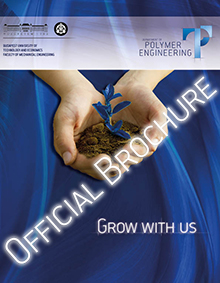Development and analysis of the effect of a 3-dimensional reinforcing frame structure with additive manufacturing from renewable resources on the morphological and mechanical properties of injection molded polymer composites
Dr. Ferenc Szabó
Dr. József Gábor Kovács
Róbert Boros
Orsolya Viktória Semperger
Dr. András Suplicz
Project summary
Due to environmental regulations and decreasing amount of raw materials, the mass and load optimization of engineering products are receiving more emphasis. Nowadays, polymer composites are more and more used in engineering applications as load-bearing structures and injection molding is one of the most often used polymer composite processing technologies, due to its high productivity and reproducibility. However, for injection molded composites, a disadvantage is that the orientation of the reinforcing fibers is determined by the flow conditions and also fiber breaking occurs during processing, thus the reinforcing possibilities of the fibers cannot be utilized to the full. In most cases, researchers attempt to solve the problem by optimizing the manufacturing technology. By contrast, we set out to develop a complex solution for the problem, which facilitates better adaptation of the reinforcing fibers and structure in injection molded structures to conditions of use, and results in better structural integrity and load bearing. The overall goal of the project is to create a complex design methodology with which a tailor-made reinforcing structure can be made in injection molded parts as a separate 3D printing step. It makes the production of a composite frame possible with directed mechanical properties within the injection molded product in one step. The reinforcing fibers are oriented previously and they keep their planned orientation during the injection molding process.
Project-related publications
- Tóth Cs., Kovács N. K.: Comparison of the accuracy of analytical models for basalt fiber–reinforced poly(lactic acid) composites prepared by injection molding and fused filament fabrication. International Journal of Advanced Manufacturing Technology, 121, 3999–4010 (2022) 10.1007/s00170-022-09572-8 IF=3.4 Q2
- Tábi T., Pölöskei K.: The effect of processing parameters and Calcium-stearate on the ejection process of injection molded Poly(Lactic Acid) products. Periodica Polytechnica-Mechanical Engineering, 66, 17-25 (2022) 10.3311/PPme.18246 IF=1.3
- Petrény R., Tóth Cs., Mészáros L., Horváth A.: Development of electrically conductive hybrid composites with a poly(lactic acid) matrix, with enhanced toughness for injection molding, and material extrusion-based additive manufacturing. Heliyon, 8, e10287/1-e10287/8 (2022) 10.1016/j.heliyon.2022.e10287 IF=4 Q2
- Tábi T.: Talkum hatása a politejsav biopolimer tulajdonságaira. in 'XXX. Nemzetközi Gépészeti Konferencia (OGÉT 2022) Székelyudvarhely, Románia. 2022.04.21-2022.04.24.,5 (2022)
- Tábi T., Ageyeva T., Kovács J. G.: The influence of nucleating agents, plasticizers, and molding conditions on the properties of injection molded PLA products. Materials Today Communications, 32, 103936/1-103936/8 (2022) 10.1016/j.mtcomm.2022.103936 IF=3.8 Q2
- Ageyeva T., Kovács J. G., Tábi T.: Comparison of the efficiency of the most effective heterogeneous nucleating agents for Poly(lactic acid). Journal of Thermal Analysis and Calorimetry, 147, 8199-8211 (2022) 10.1007/s10973-021-11145-y IF=4.4 Q1
- Csézi G., Tábi T.: Orientált biopolimer szerkezetek vizsgálata. in 'XXIX. Nemzetközi Gépészeti Konferencia (OGÉT 2021) Románia. 2021.04.23.,101-105 (2021)
- Kirchkeszner Cs., Petrovics N., Tábi T., Magyar N., Kovács J., Szabó B. S., Nyiri Z., Eke Zs.: Swelling as a promoter of migration of plastic additives in the interaction of fatty food simulants with polylactic acid- and polypropylene-based plastics. Food Control, 132, 108354/1-108354/12 (2021) 10.1016/j.foodcont.2021.108354 IF=6.652 Q1
- Tábi T.: Tények és tévhitek a biopolimerekkel kapcsolatban - II. rész. Biohulladék, 14, 21-26 (2021)
- Tábi T.: Tények és tévhitek a biopolimerekkel kapcsolatban - I. rész (másodközlés). Polimerek, 7, 298-301 (2021)
- Tábi T.: Fröccsöntött politejsav biopolimer sorozatgyárthatóságának elemzése. in 'XXIX. Nemzetközi Gépészeti Konferencia (OGÉT 2021) Románia. 2021.04.23.,200-203 (2021)
- Tábi T.: Tények és tévhitek a biopolimerekkel kapcsolatban - II. rész (másodközlés). Polimerek, 7, 337-340 (2021)
- Tóth Cs., Kovács N. K.: Additív gyártástechnológiával készült, politejsav mátrixú kompozitok vizsgálata. Polimerek, 6, 926-930 (2020)
- Pölöskei K., Csézi G., Hajba S., Tábi T.: Investigation of the thermoformability of various D-Lactide content Poly(Lactic Acid) films by ball burst test. Polymer Engineering and Science, 60, 1266-1277 (2020) 10.1002/pen.25378 IF=2.428 Q3
- Tábi T., Csézi G., Kovács N. K.: 3D nyomtatott biokompozit vázszerkezetű fröccsöntött termékek vizsgálata. Polimerek, 6, 1042-1046 (2020)






